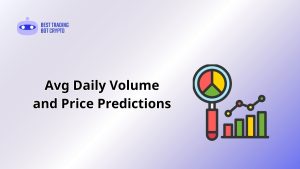The concept of avg daily volume is a cornerstone of cryptocurrency trading, offering insights into an asset’s liquidity, market interest, and price stability. It measures the average number of tokens traded daily, typically in USD, over a set period, helping traders assess how easily they can buy or sell assets like Amp (AMP), Bitcoin (BTC), or Ethereum (ETH). In 2025, with crypto markets evolving rapidly, understanding this metric is crucial for informed trading decisions. This SEO-optimized article explores the definition, significance, calculation, and impact of avg daily volume on crypto markets, providing actionable insights for traders and investors.
Contents
- 1 Defining Avg Daily Volume
- 2 Importance of Avg Daily Volume
- 3 Historical Volume Trends in Crypto
- 4 How to Calculate Avg Daily Volume
- 5 Factors Driving Avg Daily Volume
- 6 Avg Daily Volume and Price Predictions
- 7 Risks of Low Avg Daily Volume
- 8 Best Practices for Using Avg Daily Volume
- 9 How Can Avg Daily Volume Shape Your Trading Strategy?
Defining Avg Daily Volume

In cryptocurrency trading, avg daily volume, or average daily trading volume (ADTV), represents the average value or quantity of an asset traded daily over a specific timeframe, such as 7, 14, or 30 days. Expressed in USD or token units, it reflects how actively an asset is traded across exchanges like Binance, Coinbase, or Kraken. High volume indicates strong liquidity, enabling large trades with minimal price impact, while low volume suggests illiquidity, increasing volatility risks.
For instance, Amp (AMP), a collateral token on the Flexa Network, reported a 24-hour trading volume of $6.5 million to $30.03 million in July 2025, with a 30-day average of $25.74 million, per Coinbase. Bitcoin, by contrast, boasts a 24-hour volume exceeding $30 billion, showcasing its high liquidity. This metric helps traders gauge market dynamics and plan strategies.
Importance of Avg Daily Volume
The avg daily volume serves several critical functions in crypto trading:
- Liquidity Measurement: High volumes, like Bitcoin’s $30.22 billion daily average, ensure traders can execute large orders without significantly affecting prices. Low volumes, as seen with AMP’s $6.5 million on some days, indicate potential price swings.
- Market Sentiment Indicator: Rising volumes often signal increased investor interest, preceding price rallies. For example, AMP’s 121.47% volume surge in June 2025 coincided with a 40% price increase to $0.093.
- Volatility Insights: Low volumes, such as AMP’s $3.42 million in 2022, correlate with higher volatility, as fewer trades can cause larger price movements.
- Trading Strategy: Institutional traders limit positions to a small percentage (e.g., 5–10%) of daily volume to avoid slippage, a practice applicable to retail traders.
This metric is essential for assessing assets like AMP, ranked #140–#235 globally with a $284.40–$636.93 million market cap.
Historical Volume Trends in Crypto

Cryptocurrency trading volumes fluctuate with market cycles:
- 2021 Bull Market: AMP’s volume peaked above $100 million daily in June 2021, driven by its Coinbase listing and a price surge to $0.1211. Bitcoin and Ethereum saw volumes of $50 billion and $20 billion, respectively.
- 2022–2023 Bear Market: Volumes dropped significantly, with AMP averaging $3–$10 million daily and Bitcoin falling to $10–$20 billion, reflecting reduced market activity.
- 2024–2025: In 2025, AMP’s 30-day avg daily volume stabilized at $25.74 million, with peaks of $70 million in early 2025. Bitcoin’s volume averaged $30.22 billion, and Ethereum’s reached $16.62 billion, per CoinGecko and CryptoRank.
These trends highlight how volume tracks market enthusiasm, with spikes during bullish phases and declines during corrections.
How to Calculate Avg Daily Volume
Calculating avg daily volume is straightforward:
- Divide the total trading volume over a period by the number of days. For AMP, a 30-day total volume of $772.2 million yields a daily average of $25.74 million ($772.2M ÷ 30).
- For Bitcoin, a 7-day volume of $211.54 billion results in a daily average of $30.22 billion ($211.54B ÷ 7).
Exchanges like Binance ($23.43M for AMP) and Coinbase ($7.93M 24-hour, $10.28M 7-day) provide volume data, though discrepancies arise due to wash trading or platform-specific activity. Aggregators like CoinMarketCap or CryptoRank offer consolidated figures for accuracy.
Factors Driving Avg Daily Volume
Several factors influence avg daily volume in 2025:
- Market Sentiment: A Fear & Greed Index of 65 (Greed) in July 2025 drives higher volumes, as seen with AMP’s 120% surge in early 2025. Bearish periods, like 2022, reduce activity.
- Adoption and Utility: AMP’s volume grows with Flexa Network’s merchant partnerships (e.g., Regal Cinemas), while Bitcoin benefits from institutional adoption via ETFs.
- Price Volatility: Volume spikes often accompany price movements, such as AMP’s $140.28 million volume during its 40% rally in 2025.
- Regulatory Developments: The SEC’s lawsuit against AMP as a security suppressed volumes in 2023, while Bitcoin’s ETF approvals in 2024 boosted its volume.
- Market Events: Bitcoin’s halving cycles increase altcoin volumes, as seen with AMP’s 121.47% volume rise in June 2025.
X posts show optimism for volume-driven breakouts in AMP ($0.018–$0.033) but warn of whale manipulation during low-volume periods.
Avg Daily Volume and Price Predictions

The avg daily volume impacts price forecasts by signaling demand and liquidity:
- Amp (AMP): With a 30-day average of $25.74 million, 2025 price predictions range from $0.00328 to $0.02702, averaging $0.006–$0.016 (Changelly, CoinPriceForecast). High volumes support bullish targets like $0.069 (Telegaon), while low volumes align with $0.0034 (WalletInvestor).
- Bitcoin (BTC): Its $30.22 billion volume supports forecasts of $81,000–$103,332 by year-end (Finder, Coinpedia).
- Ethereum (ETH): A $16.62 billion volume underpins predictions of $3,500–$5,000, driven by DeFi and staking.
High volumes indicate strong market interest, supporting price growth, while low volumes may cap gains or increase volatility.
Risks of Low Avg Daily Volume
Low avg daily volume introduces risks:
- Illiquidity: Volumes below $10 million, as with AMP in 2022, increase price volatility, complicating large trades.
- Manipulation: Low volumes enable whale-driven price swings, as noted in X posts about AMP’s stagnation.
- Slippage: Large orders in low-volume markets cause significant price shifts, impacting profitability.
- Data Discrepancies: Volume variations across exchanges (e.g., Binance’s $23.43M vs. CryptoRank’s $6.5M for AMP) can mislead traders.
High volumes reduce these risks but may signal overbought conditions, as seen with AMP’s 316.86% price spike in early 2025.
Best Practices for Using Avg Daily Volume
To effectively use avg daily volume:
- Source Reliable Data: Track volumes on CoinGecko, CoinMarketCap, or Binance for accuracy.
- Monitor Trends: Compare 24-hour, 7-day, and 30-day volumes to spot momentum (e.g., AMP’s $25.74M 30-day average).
- Combine with Technicals: Pair volume with RSI (AMP’s 33.82, neutral) and moving averages to confirm trends.
- Limit Trade Sizes: Restrict trades to 5–10% of daily volume to avoid slippage.
- Stay Updated: Follow X posts and news for sentiment shifts driving volume changes.
How Can Avg Daily Volume Shape Your Trading Strategy?
The avg daily volume is a vital metric for navigating the crypto market in 2025, offering insights into liquidity and investor interest for assets like Amp, Bitcoin, and Ethereum. AMP’s $25.74 million 30-day average supports price predictions of $0.006–$0.016, while Bitcoin’s $30.22 billion volume underpins bullish forecasts. By tracking volume trends and combining them with technical analysis, traders can optimize strategies in a volatile market. How will you leverage avg daily volume to enhance your crypto investments in 2025?
